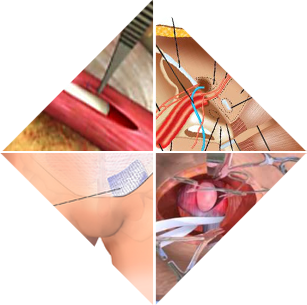
Hernia Repair Inguinal
What is it?
A hernia is a lump which occurs from a weakness in the muscles
which form the front of the body wall. Usually, the bowel or
some fat, and more rarely other organs, squeezes to this weak
spot and create a bulge in the area. In your case the hernia is
just below your groin. It is usually caused by the body wall
being weak from birth. Sometimes the body wall weakens with the
passing of time. Sometimes the body is overstrained by coughing,
heavy work or sport etc. Hernias are very common and are easily
treated. If left untreated they get bigger and cause pain. More
dangerously, the bowel can sometimes get trapped in the weak
spot of the muscles. This can cause a blockage of the bowel,
which can eventually cause it to become strangulated. An
emergency operation is then required to deal with the problem.
The Surgery
Most patients have a general anaesthetic so that they are
unconscious throughout the operation. The groin is often numbed
with local anaesthetic to cut down the pain you may experience
when you wake up. However, it is also possible to have the groin
numbed with a local anaesthetic and have the whole operation
under local anaesthetic. In this case, you will be conscious
enough during the operation to feel that something is being done
in the area of the operation but you will not feel pain. The
operation can be done under local anaesthetic when the hernia is
relatively small and your general medical condition does not
allow you to tolerate the stress of a general anaesthetic.
An incision is made into the skin overlying the hernia. The
bulge is either pushed back or is cut off. The weak part is
mended/closed and strengthened using strong stitches. Another
alternative is to patch the weak spot with a piece of synthetic
material. This is usually done when the tissues around the weak
spot are not strong enough to be stitched up together with
strong stitches or when the weak spot is so big that it is
impossible to close it just by using stitches. The synthetic
patch is placed on top of the weak spot and is stitched to the
healthy tissues around it. Soon, a lot of scarred tissue
develops above and under the patch which makes it very strong
and doesn’t allow the hernia to come back again. The cut in the
skin is then closed up. The duration of the surgery is about 40
minutes.
If you have a hernia in each groin, they can usually both be
mended at the same time. Keyhole surgery for hernia repair is
only carried out in some specialized centres and for selective
cases. It is carried out under general anaesthetic and there is
no clear evidence at the moment that it offers a significant
advantage compared to the traditionally performed operations.
Ask your surgeon to explain his own method.
You may well be able to have the operation on the day you come
in and go home the same day. You may need to stay in hospital
for a day or two, if you are over 50, having trouble passing
urine, have other illnesses, or if you cannot manage at home.
Any Alternatives
Simply waiting and seeing if you have more trouble is not a good
idea. The hernia may get worse. A truss will usually hold the
hernia back in place. It is useful as a stop-gap until you have
the operation. It might be a good decision if you do not like
the idea of an operation, or if you are not fit enough for one.

